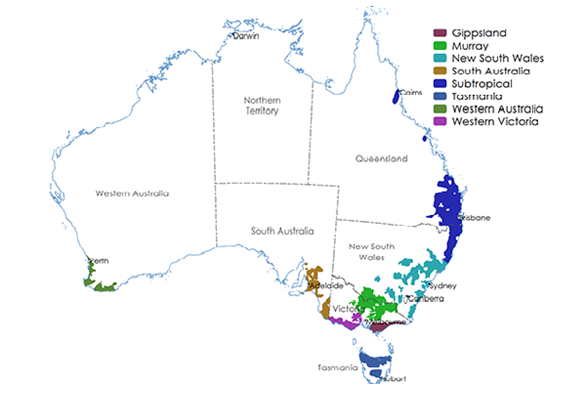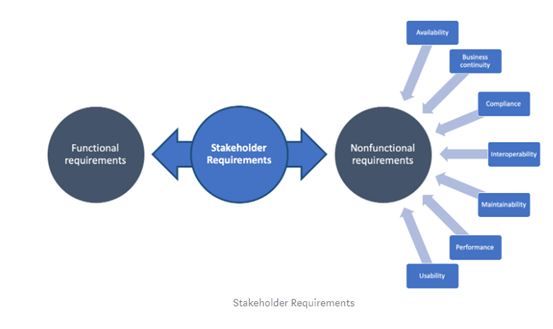Waste management assignment: Harnessing energy from Australian dairy
Question
Task: Write a waste management assignment on the project ofharnessing energy from Australian dairy wastes and also discuss about the stakeholder identification and stakeholder requirements of this project in around 1200-1300 words.
Answer
Dairy industries indicating waste in Australian map
According to the research on waste management assignment, the dairy industry provides significant contribution to the Australian economy. The industry is accounted for 7 percent of gross value and 7 percent of export income. With proper waste management, the industry is also able to produce valuable energy resources (Ma et al., 2016). There are many dairy industries practicing waste management in Australia to earn more profit in the market. Organizations manufacturing dairy products are generating both water and solid waste like milk water, packaging, wash down water and caustic solutions etc (Yatush, Lalithamba, Suresh &Arun, 2016). Diary industries in Australia are focused on reducing waste to gain profit for business and environment. They avoiddumping of waste materials and finding secondary markets for the biodegradable products. Along with this, the industries are also converting dairy waste to bioenergy like biogas, nutrient-rich solids and liquid fuel (Chen, Talebi, Gras, Weeks, and Kentish, 2018). The dairy industries having waste management is shown in the Australian map. By the map considered in the waste management assignment, dairy industries in various cities of Australia can be seen clearly.

Based on the given map within this waste management assignment, it can be seen that there are various areas like Western Australia, subtropical, western Victoria, South Australia, Murray, New South Wales and Gippsland in which dairy industries are operating. In recent years, 5,700 dairy farms are registered in Australia in which around 68 percent of those were in Victoria, 11 percent in New South Wales, 7 percent in Queensland, 7 percent in Tasmania 3 percent in Western Australia and 4 percent in South Australia. Over the past 30 years, there is the huge markedly change in the structure of Australian dairy industry (Prasad, 2006). It is also observed in the present section of waste management assignment that there are fewer resources for the diary industries in the country. Despite of fewer resources for the milk production, the industries have facilitated the increment in the gross value of dairy production per farm. Dairy farmers in these areas have adopted effective practices like reducing waste, raising the level and strength of operations, more cows per farm, and utilization of additional feeding (Australian Government, 2020).
With the waste management, Victoria is the major milk producer in the country with 64 percent of milk production in recent years. Further, New South Wales and Tasmania are contributing with 12 percent and 10 percent of total milk production respectively. These industries are focused on selecting cows with advances in breeding and genetics as these developments pro provides contribution in the milk yields per cow (Dairy Australia, 2019). Dairy industries in different regions of Australia are implementing some good practices to minimize the waste in the business operations. The industries are focused on reusing and recycling materials whenever and wherever they can. Along with this, they also ensure safe disposal of wastes by using waste contractors. The industries are focusing some processes like using less water wash down process, recovering and treating caustic and cleaning for reuse, and installing temperature sensors to keep he room cool(Kwapinska,Horvat, Liu, Leahy, 2019).
Stakeholder’s identification
Stakeholders play a crucial role in the business operations of each industry. Stakeholders can be described as the group of people having full or partial interest in the services or products offered by the organizations. Some of the stakeholders are directly connected with the operations and activities so that the set goals can be achieved. On the other hand, it is also noted in the waste management assignment that some of stakeholders are only interested in the growth and profit of the organization as they are not directly linked with the business. Basically, these people are affected by policies, objectives and decisions of the businesses (Ahmad, et al., 2019). Engagement of stakeholders in the dairy industry is the cornerstone of the development and growth of the businesses. In case of dairy industry, key stakeholders are farmers and manufacturers, customers, suppliers, government, primary industries, nongovernment groups and special interest groups and others. Basically, a diverse group of stakeholders are included in the dairy business i.e. farmers to cooperative, private sectors actors (transporters, traders, extension providers input providers processors), public sectors (regulatory authorities, extension providers), civil society stakeholders (development agencies and nongovernment organizations) and customers (Msaddak, BenNasr, Zaibet and Fridhi, 2017).
It is analyzed that core players in the dairy industry are cooperatives, processors and farmers as they are connected with the other stakeholders and engaged in formal and informal value chains. In case of formal value chains, large processors and cooperatives are engaged in the supply of bulk and market milk on the behalf of farmers. On the other hand, informal value chain includes transporters, traders and farmers selling raw milk to hotels, kiosks and customers (Aarts, Humphreys, & Gall, 2014). The analysis of stakeholders is given below:
Farmers- These are the main and important stakeholders of dairy industry. The organizations are required to have proper communication with them for regular production. They are basically engaged in farming and providing raw material to the industries. In case of dairy industry considered in the waste management assignment, raw and market milk is required for high-level production of milk products and this is possible with the farmers only. They are accountable for the continuation of supply chain and production process.
Government regulatory- In the dairy industry, government has crucial role in approving the new projects. They have keen interest in the profit and growth of the business. By implementing guidelines and regulations, government bodies compel the organizations to operate the businesses ethically. These stakeholders have high influence on the industries’ business operations. With effective rules, laws, and policies, the objectives of these government authorities are ensuring growth of the business, and paying taxes. In order to operate the business ethically, industry is required to follow all the norms and policies.
Suppliers- These stakeholders are engaged in providing raw material i.e. bulk and market milk to the organizations for the continuous production. Along with this, they are also focused on getting large number of orders from the organizations on the regular basis. For this, suppliers offer fast and early deliveries to the organizations (Ramus &Vaccaro, 2017).
Customers- Being stakeholders, customers want to purchase quality milk and products at the affordable rates. Along with this, they also keep an eye on the convenience, product prices, satisfactory customer services and quality of milk products. Loyal customers always repeat the orders and generate more revenue for the organizations. Positive and negative feedbacks given by consumers are also helpful for the dairy companies to enhance the quality of business.
Investors- In the dairy industry, investors contribute in the business by investing the money. They are also interested in higher profits to get dividends and returns in future. Raw material is required to operate the dairy business in effective manner. The organizations are required to establish a close relationship with the suppliers so that the distribution of raw milk can be done whenever required (Dowling, 2016).
What are the stakeholders’ requirements discussed in the waste management assignment? As discussed in the waste management assignment, in each business operation, there are some requirements of stakeholders which are essential to fulfil by the organizations for high profits. Those requirements of the stakeholders include functional requirements and non-functional requirements.

Functional requirements- These requirements of stakeholders mentioned in the waste management assignment include effective services offered by the organizations. Ethical and transparent business operations with effective guidelines are the functional requirements of stakeholders in the organizations.
Non-functional requirements-These requirements are basically those requirements which are not covered by the functional requirements. Non-functional requirements can also be considered as quality of service requirements, supplement requirements, and service level requirements. In case of stakeholders, there are various requirements they have in the businesses. Some of the common requirements are business continuity, availability, usability, maintainability, performance, compliance and interoperability (Kelly, Shalloo& Dillon, 2017).
Along with this, the stakeholders’ requirements in the dairy industry also include operational, human factors, environmental, logistical, production, deployment, training safety, security and interface requirements. So, it is analyzedwithin this waste management assignmentthat key stakeholders are farmers and manufacturers, customers, suppliers, government, primary industries, nongovernment groups and special interest groups and others.
References
Aarts, H. F. M., Humphreys, J., & Gall, A., 2014. Viewpoint: effective stakeholder communication in agriculture: together we stand, divided we fall. Waste management assignmentThe Journal of Agricultural Science. 152, 70.
Ahmad, T., Aadil, R.M., Ahmed, H., urRahman, U., Soares, B.C., Souza, S.L., Pimentel, T.C., Scudino, H., Guimarães, J.T., Esmerino, E.A. and Freitas, M.Q., 2019. Treatment and utilization of dairy industrial waste: A review. Trends in food science & technology.
Australian Government, 2020.Dairy industry. Accessed on 25th May 2020 from https://www.agriculture.gov.au/abares/research-topics/surveys/dairy#productivity
Chen, G.Q., Talebi, S., Gras, S.L., Weeks, M. and Kentish, S.E., 2018.A review of salty waste stream management in the Australian dairy industry. Journal of environmental management, 224, pp.406-413.
Dairy Australia, 2019.The Australian Dairy Industry Sustainability Framework.Accessed on 25th May 2020 from https://www.sustainabledairyoz.com.au/framework-principles Dowling, G. R., 2016. Winning the reputation game : creating stakeholder value and competitive advantage. MIT Press.
Kelly, P., Shalloo, L., & Dillon, P., 2017. The People in Dairy Project.Accessed on 25th May 2020 from https://www.teagasc.ie/media/website/publications/2017/The-People-in-Dairy-Project.pdf
Kwapinska, M., Horvat, A.,Liu, Y. ,&Leahy, J., 2019. Pilot Scale Pyrolysis of Activated Sludge Waste from Milk Processing Factory.Waste management assignmentAccessed on 25th May 2020 from
https://www.researchgate.net/publication/330832449_Pilot_Scale_Pyrolysis_of_Activated_Sludge_Waste_from_Milk_Processing_Factory
Ma, H., Ady, M. M., Anderson, E., Liu, W., Liu, Y., &Nie, Y., 2016.A Novel Process for Low-Sulfur Biodiesel Production From Scum Waste. .Bioresourcetechnology. 214, 826-835 Msaddak, M., BenNasr, J., Zaibet, L. and Fridhi, M., 2017. Social networks for the sustainability of the dairy sector: the role of cooperatives. Livestock Research for Rural Development, 29(2), p.2.
Prasad, P., 2006. Australian Dairy Manufacturing Industry State of the Environment Report.Accessed on 25th May 2020 from https://www.ecoefficiencygroup.com.au/wp-content/uploads/2017/11/2005-Australian-Dairy-Manufacturing-Industry-State-of-the-Environment-Report.pdf
Ramus, T., &Vaccaro, A., 2017. Stakeholders matter: How social enterprises address mission drift. Journal of Business Ethics, 143(2), 307-322.
Yatish, K. V., Lalithamba, H. S., Suresh R. &Arun, S., 2016. Optimization of Scum Oil Biodiesel Production by using Response Surface Methodology.Waste management assignmentProcess Safety and Environmental Protection. 102.












